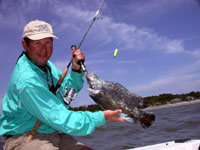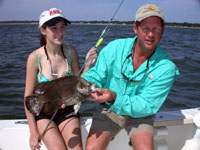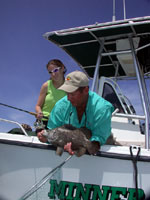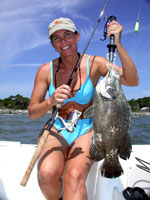
|
Features
|
|
|
|
Books
|
|
|
|
Fun & Games
|
|
|
|
Contact Us
|
|
|
John's Journal... Entry 145, Day 1
TRIPLETAIL OFF GEORGIA'S COAST
Fun Catching Tripletail and the Equipment You Need
 EDITOR'S
NOTE: If you've never experienced tripletail fishing, you've missed
one of the finest sports in all of salt-water fishing. The tripletail
resembles a giant bream and got its name because its anal and pectoral
fins sweep back towards its tail, giving the appearance of the fish having
three tails. This week we'll take you with us on a tripletail-fishing
trip to Brunswick, Georgia, with Captain Greg Hildreth. We'll also bring
you up-to-date on some of the latest research on tripletail conducted
by Jim Franks and Reed Hendon, fisheries research biologists at the University
of Southern Mississippi's College of Marine Science Center for Fisheries
Research and Development. Tripletail live in the Atlantic Ocean, the Indian
Ocean, the western Pacific Ocean and the Gulf of Mexico. But anglers nor
scientists know very much about this fun-to-catch and delicious-to-eat
fish.
EDITOR'S
NOTE: If you've never experienced tripletail fishing, you've missed
one of the finest sports in all of salt-water fishing. The tripletail
resembles a giant bream and got its name because its anal and pectoral
fins sweep back towards its tail, giving the appearance of the fish having
three tails. This week we'll take you with us on a tripletail-fishing
trip to Brunswick, Georgia, with Captain Greg Hildreth. We'll also bring
you up-to-date on some of the latest research on tripletail conducted
by Jim Franks and Reed Hendon, fisheries research biologists at the University
of Southern Mississippi's College of Marine Science Center for Fisheries
Research and Development. Tripletail live in the Atlantic Ocean, the Indian
Ocean, the western Pacific Ocean and the Gulf of Mexico. But anglers nor
scientists know very much about this fun-to-catch and delicious-to-eat
fish.
Question: Captain Hildreth, why do the tripletail
seem to come in so close to Jekyll Island off the Georgia Coast?
Answer: Nobody really knows. I believe the fish are coming to spawn
and to dodge the heavy shrimping pressure, which occurs in April and May
just outside the 3-mile limit. Although there has been little research
done on tripletail, the fish seem to be exhibiting spawning behavior.
We often see pairs of tripletail that swim around each other -- much like
tarpon do when they are daisy chaining.
Question: How big will these tripletail be that
you spot?
Answer: They'll probably weigh 2 to 15-pounds each from mid-April
until the end of May. But then further into the summer, we'll see tripletail
weighing from 10 to 25-pounds each.
 Question:
How long have you been sight fishing for these fish?
Question:
How long have you been sight fishing for these fish?
Answer: I've been patrolling the coast off Jekyll Island for about
seven years. When I first started trying to catch these fish, only one
or two other boats would be looking for them. But even today on a real
heavy weekend, you rarely will see more than 10 to 20 boats. And the fish
are spooky -- since they just appear and vanish. Not too much fishing
pressure seems to being put on them right now.
Question: How do you sight fish for tripletail?
Answer: I call our tripletail fishing south Georgia bonefishing.
I motor up and down the beach and try to spot the fish when they lay on
their sides and sun. The tripletail will be just under the surface of
the water. I attempt to see the fish's head, so I can determine which
way the fish are traveling. Then I try to maneuver the boat to get in
front of a tripletail, so I can cast to it. Usually before I get close
enough to the fish to make a cast, I'll cut off my engines and let the
boat drift to the fish and/or let the fish swim toward the boat. I always
put the wind to my back. Then I can cast with the wind past the fish and
pull the bait right in front of the fish's nose.
 Question:
What tackle are you using?
Question:
What tackle are you using?
Answer: I use a graphite Ugly Stik medium-action spinning rod with
a Shakespeare spinning reel holding 10-pound-test Trilene line when I'm
fishing for tripletail. I tie my main line straight to either a Cajun
Thunder cork or an Equalizer cork, which each have a barrel swivel at
the top and a piece of stiff wire coming from the barrel swivel down to
the float. The wire has three plastic beads on it, above the cork. After
the wire passes through the float, it has a weight on it, three more plastic
beads below the weight and then the end of the wire attaches to a second
barrel swivel. Coming off the end of the second barrel swivel is 12 inches
of 20-pound-test fluorocarbon leader with either a No. 6 Mustad hook baited
with a live shrimp or a DOA soft-plastic shrimp attached. When you pop
the cork, the beads make a clicking sound like the shrimp make, and I
believe this sound helps attract the tripletail. I like the fluorocarbon
leader because it helps make the line be as invisible as possible. We
use spinning tackle so that we can cast into the wind. The real secret
to catching the tripletail is being able to see the fish, which I do by
wearing high-quality polarized sunglasses made by Ocean Waves. These sunglasses
cut the glare and enable me to spot tripletail out to 80 to 100 yards.
Question: Once you cast to the fish and get the
bait in front of you, how does the tripletail attack the bait?
Answer: Oftentimes the tripletail will take the bait into its mouth
and even after it's eaten the bait, the fish will attack the cork. A tripletail
usually won't dive until it feels the hook or sees the boat. Most of the
time the fish won't be real aggressive on the bait.
Question: What's the biggest tripletail you have
ever caught?
Answer: 22 pounds.
Question: How many tripletails can an average
fisherman expect to catch with you?
Answer: On an average 4-hour trip, a fisherman should catch about
five tripletail.
Question: At what time do you leave port?
Answer: I usually don't go tripletail fishing until about 9:00
a.m. because the sun needs to be high and hot. The sun seems to pull the
tripletail up to the surface.
I also talked with Jim Franks about why he and his research team at the University of Southern Mississippi College of Marine Science decided to start studying the tripletail.
 Franks:
Historically, tripletail has played a big role in sport fishing along
the Gulf Coast. The tripletail is also a unique fish that many people
enjoy fishing for. The tripletail is also a mysterious fish because we
don't know anything about its migration patterns, its spawning, its age,
its growth rate or its feeding habits. Our group here at USM started studying
tripletail about four years ago. We know that the tripletail are very
similar to the cobia in their behavioral and spawning habits. In the Gulf
of Mexico, tripletail spawn off the Mississippi coast in the summer. They
are opportunistic feeders and eat a wide variety of foods. The tripletail
grow very rapidly, and they're probably long-range migrators. But we really
don't yet. We just initiated a tripletail-tagging program a couple of
years ago. The tripletail is another one of those interesting fish that
anglers are beginning to notice. However, the tripletail isn't being managed
at this time, except for the state of Florida.
Franks:
Historically, tripletail has played a big role in sport fishing along
the Gulf Coast. The tripletail is also a unique fish that many people
enjoy fishing for. The tripletail is also a mysterious fish because we
don't know anything about its migration patterns, its spawning, its age,
its growth rate or its feeding habits. Our group here at USM started studying
tripletail about four years ago. We know that the tripletail are very
similar to the cobia in their behavioral and spawning habits. In the Gulf
of Mexico, tripletail spawn off the Mississippi coast in the summer. They
are opportunistic feeders and eat a wide variety of foods. The tripletail
grow very rapidly, and they're probably long-range migrators. But we really
don't yet. We just initiated a tripletail-tagging program a couple of
years ago. The tripletail is another one of those interesting fish that
anglers are beginning to notice. However, the tripletail isn't being managed
at this time, except for the state of Florida.
* To plan a trip to the Georgia coast to catch
tripletail this year, contact Captain Greg Hildreth at (912) 261-1763.
You also can visit www.georgiacharterfishing.com
to learn more.
* I recommend you stay at the really nice Beachview Club with its
spacious rooms. The majestic water oaks surrounding the hotel help to
shade the pool and the rooms. Too, you can look out your window and see
where you'll be fishing the next morning. You can write the Beachview
Club at 721 North Beachview Drive, Jekyll Island, Georgia 31527, phone
(912) 635-2256, fax (912) 635-3770; you also can e-mail this hotel at
beachview@technonet.com
* To learn what all you can do on Jekyll Island, contact Maxine
Smith at the Jekyll Island Authority, phone (912) 635-2236 or (912) 635-4076,
fax (912) 635-4004 or e-mail her at msmith@jekyllisland.com
* For more information about the type of
sunglasses you need to wear to see the tripletail, contact Don Dingman
of Ocean Waves at (904) 509-0026 cell phone, (904) 276-1164 home phone
or by e-mail at snole1@fbn.com
* To tag tripletail and help fisheries scientists with their research,
contact Jim Franks or Reed Hendon at the University of Southern Mississippi
College of Marine Science Center by calling (228) 872-4202 or e-mailing
jim.franks@usm.edu or reed.hendon@usm.edu
TOMORROW: WEIRD WAYS TO CATCH TRIPLETAIL
Check back each day this week for more TRIPLETAIL OFF GEORGIA'S COAST ...
Day 1 - Fun Catching Tripletail
and the Equipment You Need
Day 2 - Weird Ways to Catch Tripletail
Day 3 - What You're Going To Catch
Day 4 - The Secret of Blackbeard's Tripletail
Day 5 - When Do the Tripletail Start Invading
the Channel Markers?